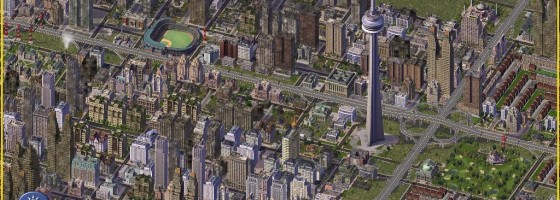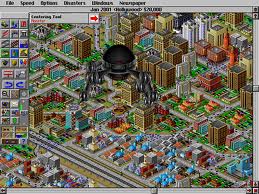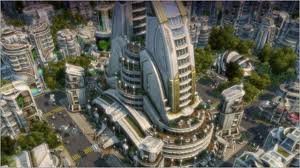The city builder genre was one of my favorites growing up and the recent sale on Good Old Games of several of the Impressions series made me start to think about how the genre has grown and has become stuck in a sense. Looking back we can almost chart the development of the genre through the different games that have defined it.
The Train Parallel:
When I think about why I enjoyed city builders, I associate it with people who love building train sets. There is that sense of accomplishment of seeing something that you put together not only run, but run efficiently. Watching multiple trains go at the same time, without any crashes on the path that you designed. And that same feeling also exists with the best city builders.
Learning a city builder like SimCity is not a simple task, as you had multiple interconnected systems of population growth, public services, taxes, beautification and more to deal with. Building a massive city that keeps everything in check is a major accomplishment. With that said let’s turn back the clock and look at some of the games that defined the genre.
Simming it Up:
Long before people knew who the Sims were they had to build them cities in SimCity. The original SimCity released in 1989 laid the groundwork for the city builder genre. Players could choose from either playing randomly generated maps or scenarios where they had to restore a city after a major disaster.
There was no hand-holding or limiting the player’s choices. The player had the freedom to build a city to their specifications. As long as they had the money, they could build whatever structure they wanted when they wanted.
Interestingly, while there was no pre-defined sense of progression due to the freedom of building a city, there was still in game progression in the form of building newer buildings.
Since the player started with everything unlocked they could see the difference between having a small water tower provide coverage, or a giant water purification plant. But without the money, they couldn’t build it without bankrupting the city.
This paralleled real life city development, as everyone wants their city to be a utopia, but the cost is just too great. The only option both in life and in SimCity was to try to make your perfect city slowly, by saving up money from taxes and buying those great services one at a time.
The problem with SimCity as a brand, was that it was more of a sandbox then an actual game, hence the reason for the scenarios. For people who wanted more of a focus or challenge it would take another series to start that.
The Impressions Age:
In the 90s we saw more strategy or even puzzle design added to the city builder genre. And the Impressions city builders are considered the highlight of this style. Starting with Caesar in 1992, the Impressions series were set up differently compared to SimCity.
Where in SimCity you were given freedom to do what you wanted in a modern era setting. With Caesar you had goals to accomplish to win each map. The focus on a historical setting also meant that players had to build their cities using the conventions of the time: meaning no water plants or police but aqueducts and guards.
The shift to the mission structure also made the Impressions series more puzzle like compared to SimCity. As each map challenged the player to accomplish the goals under the limitations of the map or unlocked structures.
This also made it easier to learn these games compared to the open ended design of SimCity, as the player wouldn’t be overwhelmed with dozens of buildings from the get-go. They could play the campaign, understand the concepts then try building a city outside of the campaign.
Over the 90s, we saw many new series released that followed the Impressions style of challenging the player to build in a different setting. Such as Stronghold, Tropico, and Startopia among others.
While the option was there to have a free play mode in some of these games, the popularity came down to their campaigns that offered the player a challenge.
The other major part of early city builders was the “walker system”. Your people couldn’t just go everywhere they pleased, but had to follow the road systems that you laid out. If someone was dying of thirst, unless that well was attached to a road, it didn’t exist to them. In early games, the reason was due to the limited technology at the time while later series removed that limit.
When former Impressions employees left and started Tilted Mill in 2001, expectations were high to see what could become the next generation of city builders.
Tilted Views:
Tilted Mill did break the conventions of the genre during its brief time in the last decade. Their first title was Children of the Nile, which was in a way a spiritual sequel to Pharaoh, changed a lot of the conventions of the genre.
First was the removal of requiring roads, while roads would help people move quicker, villagers could interact with any buildings they wanted. As in previous city builders, you had the option of a campaign or open ended maps to build your cities in.
The big change that I loved about CoTN was how organic the game was compared to other city builders. You had four classes of people living in your city: the farmers or serfs, shopkeepers, government workers and the noble elites. Each group needed the support of the other three to maintain their lifestyles.
Farmers, who worked for the elite, grew food that would be split between their wages and given back to the nobles, along with being taxed and given to you. The food in turn would be used to pay for the products made by shopkeepers that everyone buys. Meanwhile government workers are paid by the food that is taxed when it is harvested and provide special services around the city.
There were a lot of resources to keep track of, from basic food, to marble and even educated citizens. As in SimCity, buildings weren’t locked behind campaigns but instead by the available materials.
Building a monument required a lot of time, people and resources and was really an achievement for getting one finished.
The interconnection of systems, people and materials really elevated CoTN in my opinion. Building a mining colony wasn’t something that was done by plopping down buildings. You had to actually build a little mining town complete with basic services and shops along with a way of moving the mined materials back to your main city to be worked on.
However, while CoTN braved new territory it also suffered from accessibility problems and growing pains within the genre. How the game worked was that the # of elite people you have in your town dictated how many farmers you could have. More farmers= more food which was a major source of currency. To get more elite people you needed to raise the prestige of your city, this meant keeping people happy and building monuments.
The problem was that if you start losing people due to problems, it was very hard to dig yourself out of a hole. For example: let’s say that you just used your materials and educated citizen to build a school to educate children. But then malaria breaks out and your people want a hospital, but you don’t have enough resources or educated citizens, even if you demolish the school. Because of that, the people are now pissed and your prestige takes a hit.
People also remembered your failures for a very long time further complicating matters. The game also had random events and there was no bigger game killer then losing your Pharaoh due to disease before you could build prestige boosting buildings. While the game featured campaigns, the in game progression worked by having the people want more buildings and services as time went on. Meaning that if you weren’t quick enough to fix one problem; more issues would spring up before too long.
Since the game was very loose in terms of placing structures, there was no information about how much a building produces or what was considered optimal placement. You could annoy people by placing a shop too far away, but wouldn’t know about it until afterwards.
After CoTN Tilted Mill went on to create Hinterland, which was one of my favorite flawed gems of all time. They also released SimCity Societies which sadly did not do so well. Early reviews found a lot of bugs in the game along with annoying copy protection. And many fans of SimCity didn’t like the change Tilted Mill did to the progression.
In Societies, the player could build structures that would tilt the city towards different philosophies. Such as building cameras and security centers for a Big Brother type city, or banks and such for high rises and corporations. I found the idea interesting as it gave the game a progression, but fans didn’t like playing a city builder with so many of the toys locked at the start.
Personally I enjoyed the titles from Tilted Mill and thought that the changes to the city builder genre were a great step forward.
Present Day’s View of the Past and Future:
Today the city builder genre has shrunk for the most part. Currently the main developer is Blue Byte with the Anno and Settler series.
While I enjoyed their games, I’m not completely sure if I would call them city builders. They feel more like economic strategy games, as the building of the city exists mainly for combat and troop supply. Keeping people happy is very binary; as long as they have products nearby they’re good.
The big difference between the Anno series and something like CoTN was how materials were handled. Both games featured a lot of materials for the player to harvest, build, or process. But where CoTN used each material for different purposes and buildings, in Anno things were different. A material would be used either directly, or as a part of making a more complicated material.
The Anno series lack the organic feel from older city builders, especially CoTN. I think part of it is due to the greater focused on combat, so it feels more “gamey” in that way. The series doesn’t have that same level of interconnection of systems as titles like SimCity or CoTN had.
It was very easy to “game” the system as outside of the greater needs of the elite class, nothing really changed in terms of keeping people happy. But things are looking up for us city managers, as preview videos of the new SimCity from Maxis have been making rounds and are looking good.
Whether you view a city builder as a slow paced strategy game, real world simulator, or a historical sandbox, there is still nothing like looking down on the city you made… before smashing a meteor into it.
I have two dream projects that I would love to make for the city builder genre. The first is a Civilization themed city builder, where you create a city that evolves over different eras.
While the other one that I’ve talked about is a more complex version of Hinterland. Essentially I would like it to be Dark Souls meets Children of the Nile. Which given the pedigree of those two games, I figure if I ever make a kickstarter for that idea I’ll either make 5 million in one day, or 25 cents in a month.






Pingback: System Heavy Game Design | Game Wisdom()